DALI
Development and Advancement of Lunar Instrumentation (DALI)
Soil Analysis
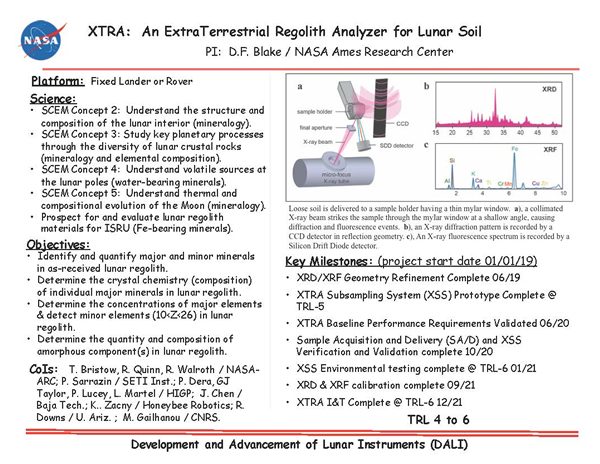 An Extra Terrestrial Regolith Analyzer for Lunar Soil (XTRA)
An Extra Terrestrial Regolith Analyzer for Lunar Soil (XTRA)
• SCEM Concept 2: Understand the structure and composition of the lunar interior (mineralogy).
• SCEM Concept 3: Study key planetary processes through the diversity of lunar crustal rocks (mineralogy and elemental composition).
• SCEM Concept 4: Understand volatile sources at the lunar poles (water-bearing minerals).
• SCEM Concept 5: Understand thermal and compositional evolution of the Moon (mineralogy).
• Prospect for and evaluate lunar regolith materials for ISRU (Fe-bearing minerals).
Seismometer
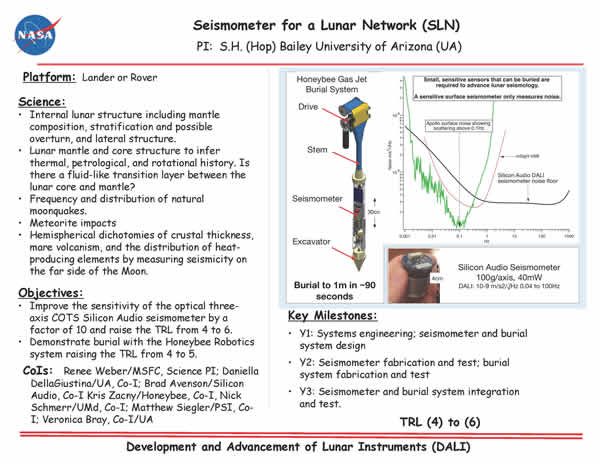 Seismometer for a Lunar Network (SLN)
Seismometer for a Lunar Network (SLN)
• Internal lunar structure including mantle composition, stratification and possible overturn, and lateral structure.
• Lunar mantle and core structure to infer thermal, petrological, and rotational history. Is there a fluid-like transition layer between the lunar core and mantle?
• Frequency and distribution of natural moonquakes.
• Meteorite impacts
• Hemispherical dichotomies of crustal thickness, mare volcanism, and the distribution of heat producing elements by measuring seismicity on the far side of the Moon.
Laser Experiment
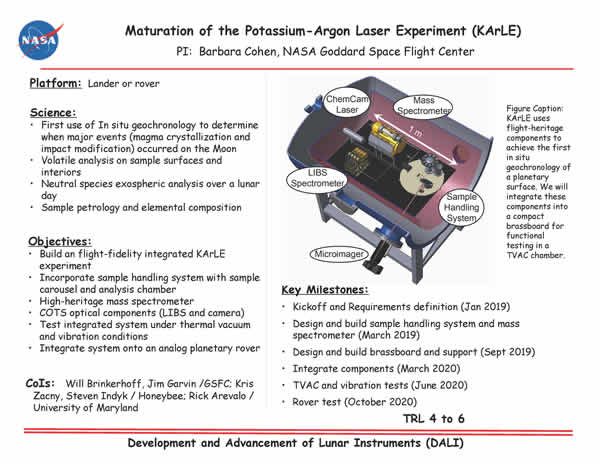 Maturation of the Potassium-Argon Laser Experiment (KArLE)
Maturation of the Potassium-Argon Laser Experiment (KArLE)
• First use of In situ geochronology to determine when major events (magma crystallization and impact modification) occurred on the Moon
• Volatile analysis on sample surfaces and interiors
• Neutral species exospheric analysis over a lunar day
• Sample petrology and elemental composition
Dust Processes
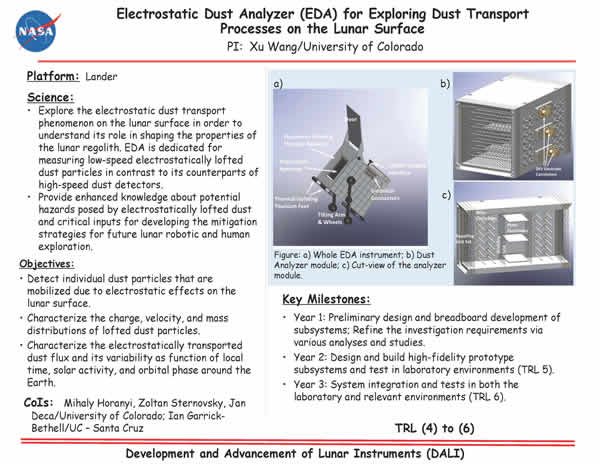 Electrostatic Dust Analyxer (EDA) for Exploraing Dust Transport Processes on the Lunar Surface
Electrostatic Dust Analyxer (EDA) for Exploraing Dust Transport Processes on the Lunar Surface
• Explore the electrostatic dust transport phenomenon on the lunar surface in order to understand its role in shaping the properties of the lunar regolith. EDA is dedicated for measuring low-speed electrostatically lofted dust particles in contrast to its counterparts of high-speed dust detectors.
• Provide enhanced knowledge about potential hazards posed by electrostatically lofted dust and critical inputs for developing the mitigation strategies for future lunar robotic and human exploration.
Surface Study
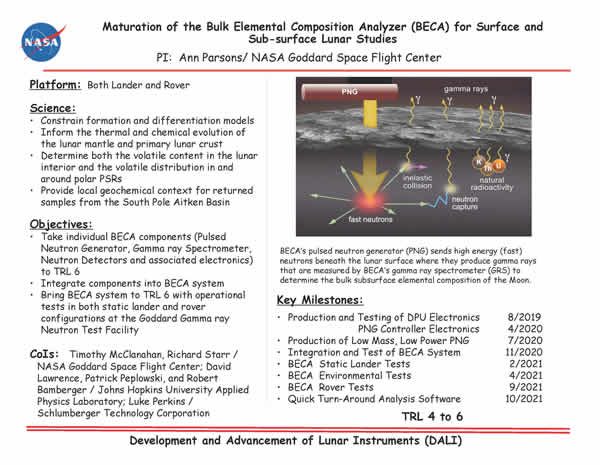 Maturation of the Bulk Elemental Composition Analyzer (BECA) for Surface and Sub-surface Lunar Studies
Maturation of the Bulk Elemental Composition Analyzer (BECA) for Surface and Sub-surface Lunar Studies
• Constrain formation and differentiation models
• Inform the thermal and chemical evolution of the lunar mantle and primary lunar crust
• Determine both the volatile content in the lunar interior and the volatile distribution in and around polar PSRs
• Provide local geochemical context for returned samples from the South Pole Aitken Basin
Atomic Seismometer
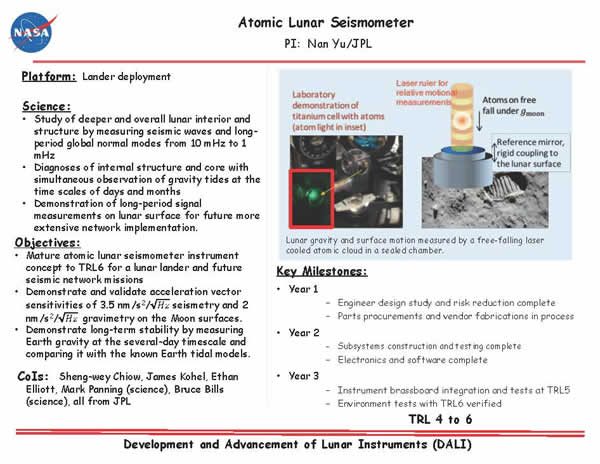 Atomic Lunar Seismometer
Atomic Lunar Seismometer
• Study of deeper and overall lunar interior and structure by measuring seismic waves and longperiod global normal modes from 10 mHz to 1 mHz
• Diagnoses of internal structure and core with simultaneous observation of gravity tides at the time scales of days and months
• Demonstration of long-period signal measurements on lunar surface for future more extensive network implementation.
Lunar Volatiles
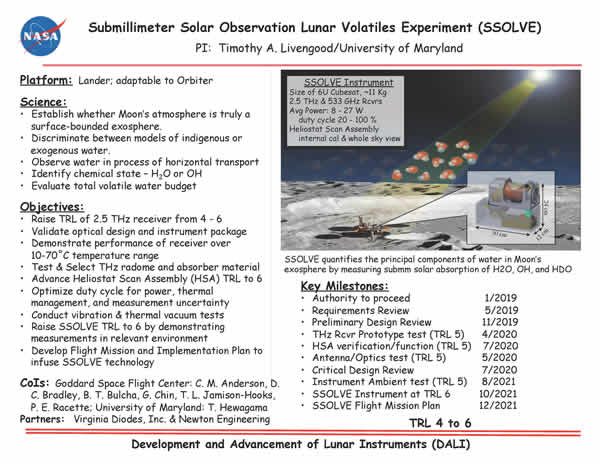 Submillimeter Solar Observation Lunar Volatiles Experiment (SSOLVE)
Submillimeter Solar Observation Lunar Volatiles Experiment (SSOLVE)
• Establish whether Moon’s atmosphere is truly a surface-bounded exosphere.
• Discriminate between models of indigenous or exogenous water.
• Observe water in process of horizontal transport
• Identify chemical state – H2O or OH
• Evaluate total volatile water budget
Environment Monitoring
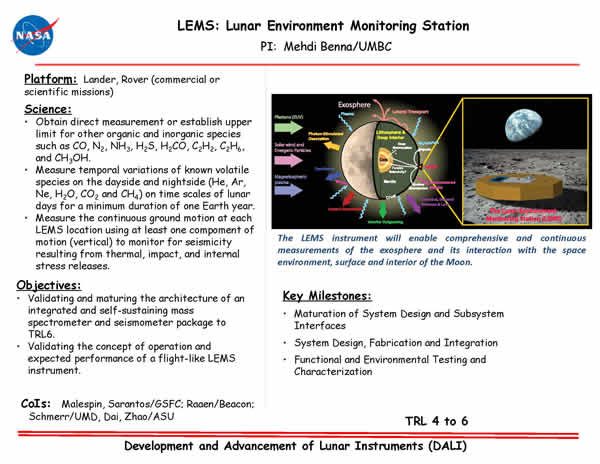 Lunar Environment Monitoring Station (LEMS)
Lunar Environment Monitoring Station (LEMS)
• Obtain direct measurement or establish upper limit for other organic and inorganic species such as CO, N2, NH3, H2S, H2CO, C2H2, C2H6, and CH3OH.
• Measure temporal variations of known volatile species on the dayside and nightside (He, Ar, Ne, H2O, CO2 and CH4) on time scales of lunar days for a minimum duration of one Earth year.
• Measure the continuous ground motion at each LEMS location using at least one compoment of motion (vertical) to monitor for seismicity resulting from thermal, impact, and internal stress releases.
Regolith Study
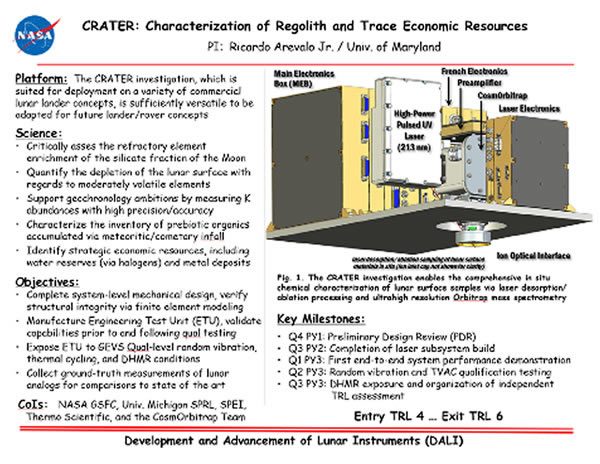 Characterization of Regolith and Trace Economic Resources (CRATER)
Characterization of Regolith and Trace Economic Resources (CRATER)
• Critically assess the refractory element enrichment of the silicate fraction of the Moon
• Quantify the depletion of the lunar surface with regards to moderately volatile elements
• Support geochronology ambitions by measuring K abundances with high precision/accuracy
• Characterize the inventory of prebiotic organics accumulated via meteoritic/cometary infall
• Identify strategic economic resources, including water reserves (via halogens) and metal deposits
Imaging Spectrometer
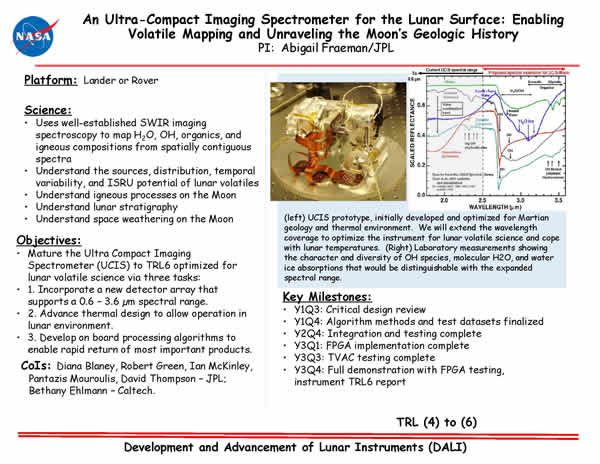 An Ultra-Compact Imaging Spectrometer for the Lunar Surface: Enabling Volatile Mapping and Unraveling the Moon’s Geologic History
An Ultra-Compact Imaging Spectrometer for the Lunar Surface: Enabling Volatile Mapping and Unraveling the Moon’s Geologic History
• Uses well-established SWIR imaging spectroscopy to map H2O, OH, organics, and igneous compositions from spatially contiguous spectra
• Understand the sources, distribution, temporal variability, and ISRU potential of lunar volatiles
• Understand igneous processes on the Moon
• Understand lunar stratigraphy
• Understand space weathering on the Moon
